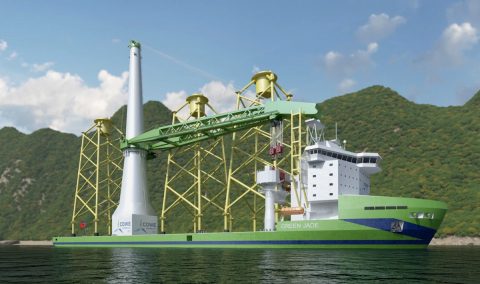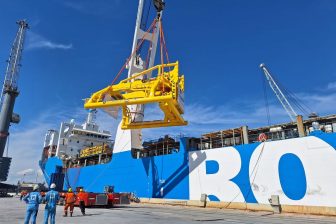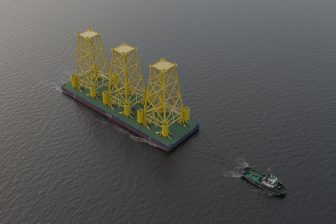
DEME opts for Huisman crane for new installation vessel
DEME has opted for a Huisman crane for its new installation vessel Green Jade, which is being built in cooperation with Taiwanese shipbuilder CSBC. The crane will be built at Huisman’s facility in China and is scheduled for delivery in 2022.
The offshore mast crane will be capable of lifting 4,000 tonnes at 125 metres above deck. It will be outfitted with specific auxiliary systems for handling tall structures to enable Green Jade to install the next generation of foundations and giant wind turbines, Huisman states.
The crane will also be prepared for a super fly jib with significant lifting capacity and a whip hoist, which allows lifting of smaller components up to a height of 185 meters above deck. In addition to the main crane, Huisman will also deliver a 65-tonne knuckleboom crane for general lifting purposes. Both cranes will be installed and commissioned at the CSBC shipyard.
The crane will be designed with a small footprint to leave a maximum amount of space for project cargo. A crane with such lifting height impacts the vessel’s stability because of the large weight of the crane and the high centre of gravity. To minimize this impact, Huisman has developed a mast crane concept whereby the winches are located at deck level instead of at the level of the slew platform.
“We are very pleased with the confidence shown in Huisman by awarding us this contract”, comments project director Anne de Groot of Huisman.
Liebherr
For its previous newbuilding, the Orion, DEME opted for a Liebherr crane, which would be the manufacturer’s first crane in the 5,000-tonne range. The delivery of this vessel has been significantly delayed following an accident while performing an overload test.
Liebherr had planned to do an overload test by lifting a 5,500-tonne barge but at about half of the load, the third-party hook snapped causing the barge to drop and the crane to collapse.
In an attempt to limit the damage to its reputation, Liebherr was quick to say that a design error of the crane could be ruled out as the cause for the accident was a faulty hook. Hook designer Ropeblock confirmed that a broken hook caused the incident, which is currently being investigated.
You just read one of our premium articles free of charge
Register now to keep reading premium articles.




